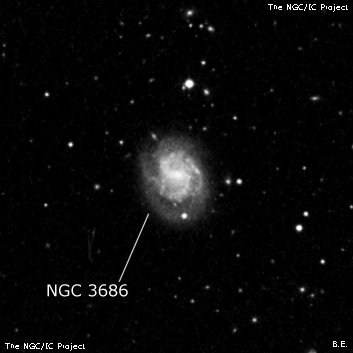
William Herschel discovered NGC 3686 = H III-28 = h894 on 14 Mar 1784 (sweep 170) and logged "vF, L, r." His position is 15 sec of RA due east of UGC 6460. His observation of II-160 a month later on 17 Apr 1784 was assumed by JH and Dreyer to be a duplicate observation, but Wolfgang Steinicke analyzed the sweep and found II-160 applies to NGC 3684 instead.
JH observed h894 on 3 sweeps recording "pB; pL. (N.B. II 160 and III 28 are probably identical". On a second sweep he noted "B; L; R; bM; has a L star north and a smaller one south". Finally he logged "B; vL; E; vgbM; 2' diam. Near a *." Dreyer followed JH's comment in his first sweep and commented in his 1912 "Scientific Papers of William Herschel" that the transit for II 160 must have been recorded 1 tmin too late.
300/350mm - 13.1" (1/18/85): brightest and largest in a group (LGG 237) with NGC 3681, NGC 3684 and NGC 3691. Elongated 4:3 ~N-S, 3.0'x2.4', brighter core. An extremely faint star or knot is involved. A mag 11 star lies 2.6' N of center. NGC 3684 is 14' SSW and NGC 3691 19' SSE.
600/800mm - 24" (5/27/17): at 200x; bright, very large, slightly elongated ~N-S, broad mild concentration with a relatively large slightly brighter core and a small brighter nucleus. A 14th magnitude star is on the south edge of the halo, 1.2' from center. The halo extends ~2.5'x2.0' and encompasses this star.
Notes by Steve Gottlieb